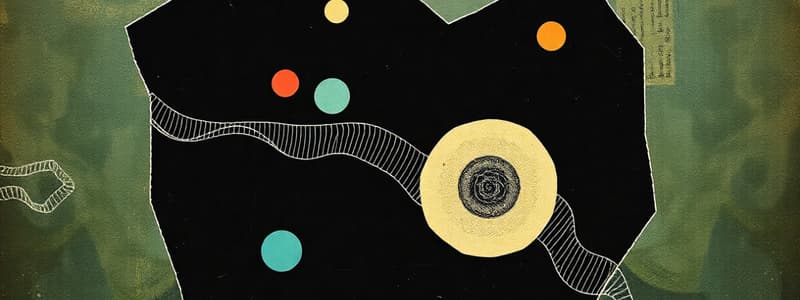Podcast
Questions and Answers
What characterizes ungated or leak channels?
What characterizes ungated or leak channels?
- They respond to mechanical stimuli.
- They can only open with a change in voltage.
- They require a specific ligand to open.
- They are always open. (correct)
What is the primary function of neurohormones in the body?
What is the primary function of neurohormones in the body?
- To transport nutrients into the cells
- To regulate temperature within the body
- To release hormones into the bloodstream for distant target cells (correct)
- To facilitate communication between neurons only
Which type of channel opens in response to changes in electrical potential?
Which type of channel opens in response to changes in electrical potential?
- Ligand-gated channels
- Voltage-gated channels (correct)
- Leak channels
- Mechanically gated channels
Which mechanism requires no energy for the transport of substances?
Which mechanism requires no energy for the transport of substances?
How do ligand-gated channels function?
How do ligand-gated channels function?
Which type of diffusion occurs through the lipid bilayer of the cell membrane?
Which type of diffusion occurs through the lipid bilayer of the cell membrane?
What triggers mechanically gated channels to open?
What triggers mechanically gated channels to open?
Which type of transport is facilitated by protein channels in cell membranes?
Which type of transport is facilitated by protein channels in cell membranes?
What characterizes passive transport mechanisms?
What characterizes passive transport mechanisms?
What is a characteristic of simple diffusion through the lipid bilayer?
What is a characteristic of simple diffusion through the lipid bilayer?
What role do intercellular communications play in multicellular organisms?
What role do intercellular communications play in multicellular organisms?
Which type of intercellular communication involves physical contact between cells?
Which type of intercellular communication involves physical contact between cells?
What characterizes the action of paracrine chemical messengers?
What characterizes the action of paracrine chemical messengers?
What distinguishes neurotransmitters from hormones in terms of their action range?
What distinguishes neurotransmitters from hormones in terms of their action range?
What is the main function of hormones in the context of intercellular communication?
What is the main function of hormones in the context of intercellular communication?
Flashcards are hidden until you start studying
Study Notes
Intercellular Communication
- Most cells are not in direct contact with the external environment.
- Direct communication: Cells are physically connected through structures like gap junctions.
- Indirect communication: Cells use extracellular chemical messengers, which are secreted by cells and act on target cells to exert their effects.
- Paracrine messengers: These messengers act locally on neighboring cells.
- Neurotransmitters: Released by nervous cells in response to electrical signals. They act on nearby target cells, including other neurons, muscles, and glands.
- Hormones: Long-range messengers secreted by endocrine glands into the bloodstream. They travel to distant target cells to elicit responses.
- Neurohormones: Hormones released by neurosecretory neurons into the blood.
Transport Across Cell Membrane
- Cells need to exchange substances with their environment.
- Passive transport: Movement of substances along concentration or electrical gradients (downhill). It does not require energy.
- Simple diffusion: Substances move directly through the lipid bilayer or protein channels of the cell membrane.
- Facilitated diffusion: Substances are transported across the membrane with the help of carrier proteins.
- Active transport: Movement of substances against concentration, electrical, or electrochemical gradients (uphill). It requires energy.
- Primary active transport: Energy is directly obtained from the breakdown of ATP.
- Secondary active transport: Energy for the movement of one substance is obtained from the movement of a second substance, often coupled through a carrier protein.
Homeostasis
- Homeostasis: Maintaining a stable internal environment within a narrow range, despite external fluctuations, is vital for life.
- Components of a homeostatic control system:
- Sensors (receptors): Detect changes in the internal environment.
- Control center: Receives information from sensors and sends out commands to effectors.
- Effectors: Carry out the adjustments to correct deviations from the set point.
- Negative feedback: The response opposes the initial stimulus, bringing the system back towards a set point.
- Positive feedback: The response amplifies the initial stimulus.
Examples of Homeostatic Mechanisms
- Negative feedback examples: Regulation of blood pressure, body temperature, and blood glucose levels.
- Positive feedback examples: Blood coagulation, labor, and membrane excitation.
Homeostasis Disturbance Example: Fever (Pyrexia)
- Pyrogens: Substances that trigger fever. They can be released by bacteria or from degenerating tissues.
- Macrophages: These immune cells engulf pyrogens and release interleukin-1 (an endogenous pyrogen).
- Prostaglandins (PGE2): Interleukin-1 stimulates the formation of prostaglandins, which raise the set point of the body's internal thermostat.
- The higher set point triggers heat production mechanisms, leading to a fever.
Studying That Suits You
Use AI to generate personalized quizzes and flashcards to suit your learning preferences.


